Israeli new shekel
| Template:Hebrew (Hebrew) شيكل جديد (Arabic) | |
|---|---|
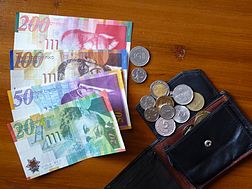 New shekel banknotes and coins (Series B) | |
| ISO 4217 | |
| Code | ILS (numeric: 376) |
| Subunit | 0.01 |
| Unit | |
| Plural | shekels sheqalim |
| Symbol | ₪ |
| Denominations | |
| Subunit | |
| 1⁄100 | agora |
| Plural | |
| agora | agoras agorot |
| Banknotes | ₪20, ₪50, ₪100, ₪200 |
| Coins | 10 agorot, ₪½, ₪1, ₪2, ₪5, ₪10 |
| Demographics | |
| User(s) | |
| Issuance | |
| Central bank | Bank of Israel |
| Website | boi |
| Printer | Orell Füssli[2] |
| Mint | KOMSCO[3] |
| Valuation | |
| Inflation | −0.2% (2016) |
| Source | Bank of Israel, August 2016[4] |
The Israeli new shekel (Template:Lang-he ; Template:Lang-ar šēkal jadīd; sign: ₪; code: ILS), also known as simply the Israeli shekel and formerly known as the New Israeli Sheqel (NIS), is the currency of Israel and is also used as a legal tender in the Palestinian territories of the West Bank and the Gaza Strip. The new shekel is divided into 100 agora. The new shekel has been in use since 1 January 1986, when it replaced the hyperinflated old shekel at a ratio of 1000:1.
The currency sign for the new shekel ⟨ ₪ ⟩ is a combination of the first Hebrew letters of the words shekel (ש) and ẖadash (ח) (new). Alongside the shekel sign, the following abbreviations of NIS, ש"ח and ش.ج are also used commonly to denominate prices.
History
The origin of the name "shekel" (שקל) is from the ancient biblical currency by the same name. Shekel is any of several ancient units of weight or of currency in ancient Israel. Initially, it may have referred to a weight of barley. In ancient Israel, the shekel was known to be about 180 grains (11 grams or .35 troy ounces).
From the formation of the modern State of Israel on 14 May 1948 through 1952 banknotes continued to be issued by the Anglo-Palestine Bank as the Palestine pound which was pegged to the British Pound.[5][5] In 1952, the Anglo-Palestine Bank changed its name to Bank Leumi Le-Yisrael (National Bank of Israel) and the currency name became the Israeli pound.[6]
Israeli pound (1952–1980)
The Israeli pound (לירה ישראלית, "Lira Yisraelit") was the currency of the State of Israel from June 1952 until 23 February 1980, when it was replaced with the shekel on 24 February 1980. From 1955, after the Bank of Israel was established and took over the duty of issuing banknotes, only the Hebrew name was used, along with the symbol "I£".[7] The pegging to the British Pound was abolished on 1 January 1954, and in 1960, the sub-division of the Israeli pound was changed from 1000 prutot to 100 agorot.
During the 1960s, a debate over the non-Hebrew name of the Israeli currency resulted in a law ordering the Minister of Finance to change the name pound into a Hebrew name, Shekel (שקל). The law allowed the minister to decide on a proper date for the change. The law did not come into effect until February 1980, when the Israeli government decided to change the monetary system and introduce the shekel at a rate of 1 shekel = I£10.
Shekel (1980–1985)
The shekel, now known as the old shekel, was the currency of the State of Israel between 24 February 1980 and 31 December 1985. Both it and its predecessor the Israeli pound experienced frequent devaluations against foreign currencies during the 1960s and '70s. This trend culminated in the old shekel experiencing hyperinflation in the early 1980s. After inflation was contained as a result of the 1985 Economic Stabilization Plan, the new shekel was introduced, replacing the old shekel on 1 January 1986 at a rate of IS 1,000 to ₪1.
New shekel (1985–present)
Since the economic crisis of the 1980s and the subsequent introduction of the new shekel in 1985, the Bank of Israel and the government of Israel have maintained much more careful and conservative fiscal and monetary policies, and have gradually introduced various market-based economic reforms. In addition, the signing of free trade agreements helped the Israeli economy become more competitive, while heavy investment in its industrial and scientific base allowed the country to take advantage of opportunities associated with the rise of the global knowledge economy, thus greatly increasing exports and opening new markets for its products and services. As a result of these factors, inflation has been relatively low and the country now maintains a positive balance of payments, with a current account surplus equivalent to about 3% of its GDP in 2010. Consequently, its currency has strengthened considerably, rising approximately 20% in value relative to the US dollar in the 2000s decade, thereby reversing the trend of historical weakness the Israeli currency exhibited in the decades prior.
Since 1 January 2003, the new shekel has been a freely convertible currency. Since 7 May 2006, new shekel derivative trading has also been available on the Chicago Mercantile Exchange.[8] This makes the new shekel one of only twenty or so world currencies for which there are widely available currency futures contracts in the foreign exchange market. It is also a currency that can be exchanged by consumers in many parts of the world.[9][10] On 26 May 2008, CLS Bank International announced that it would settle payment instructions in new shekels, making the currency fully convertible.[11] Since 20 March 2003, the new shekel has gained more than 44% in value against the US dollar.[12]
Coins
In 1985, coins in denominations of 1 agora, 5 and 10 agorot and ₪½ and ₪1 were introduced.[13] In 1990, ₪5 coins were introduced,[14] followed by ₪10 coins in 1995.[15] Production of 1 agora pieces ceased in 1990, and they were removed from circulation on 1 April 1991.[citation needed] A ₪2 coin was introduced on 9 December 2007.[16] The 5 agora coin, last minted in 2006, was removed from circulation on 1 January 2008.[17]
In April 2011, it was reported that new coins would be minted that would use less metal and thus lower costs. Counterfeiting would also be harder.[18] The Bank of Israel is considering dropping the word "new" on the planned coins series. If approved, this would be the first replacement of all coins since the introduction of the new shekel coins in September 1985.[19] The coins are minted by the Korea Minting and Security Printing Corporation (KOMSCO).[3]
| Image | Value | Technical parameters | Description | Date of | ||||||
|---|---|---|---|---|---|---|---|---|---|---|
| Diameter | Thickness | Mass | Composition | Edge | Obverse | Reverse | issue | withdrawal | ||

|
1 agora | 17 mm | 1.2 mm | 2 g | Aluminium bronze 92% copper 6% aluminium 2% nickel |
Plain | Ancient galley, the state emblem, "Israel" in Hebrew, Arabic and English | Value, date | 4 September 1985 | 1 April 1991 |
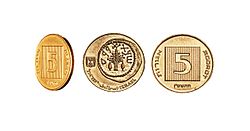
|
5 agorot | 19.5 mm | 1.3 mm | 3 g | Replica of a coin from the fourth year of the war of the Jews against Rome depicting a lulav between two etrogim, the state emblem, "Israel" in Hebrew, Arabic and English | 1 January 2008 | ||||
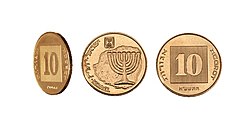
|
10 agorot | 22 mm | 1.5 mm | 4 g | Replica of a coin issued by Antigonus II Mattathias with the seven-branched candelabrum, the state emblem, "Israel" in Hebrew, Arabic and English | Current | ||||
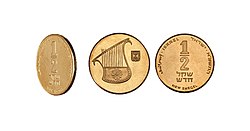
|
₪½ | 26 mm | 1.6 mm | 6.5 g | Lyre, the state emblem | Value, date, "Israel" in Hebrew, Arabic and English | ||||
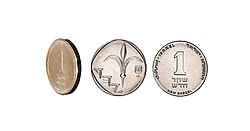
|
₪1 | 18 mm | 1.8 mm | 3.5 g | Cupronickel 75% copper 25% nickel (1985-1993) Nickel-plated steel (1994–present)[20] |
Lily, "Yehud" in ancient Hebrew, the state emblem | ||||

|
₪2 | 21.6 mm | 2.3 mm | 5.7 g | Nickel-plated steel | Segmented (Plain and Reeded sections) | Two cornucopia, the state emblem | 9 December 2007 | ||

|
₪5 | 24 mm | 2.4 mm | 8.2 g | Cupronickel 75% copper 25% nickel |
12 sides | Capital of column, the state emblem | 2 January 1990 | ||
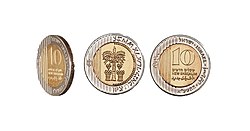
|
₪10 | 23 mm Core: 16 mm |
2.2 mm | 7 g | Ring: Nickel-bonded steel Center: Aureate-bonded bronze |
Reeded | Palm tree with seven leaves and two baskets with dates, the words "for the redemption of Zion" in ancient and modern Hebrew alphabet | 7 February 1995 | ||
| For table standards, see the coin specification table. | ||||||||||
- Note that all dates on Israeli coins are given in the Hebrew calendar and are written in Hebrew numerals.
Banknotes
Series A (1985–1999)
Beginning on 4 September 1985, banknotes were introduced in denominations of ₪5, ₪10, and ₪50. An ₪1 note followed on 8 May 1986 and the ₪20 note issued on 2 April 1988 completed the family.[21] The ₪1, ₪5 and ₪10 notes used the same basic designs as the earlier IS 1000, 5000, and 10 000 notes but with the denominations altered.
In 1986, ₪100 notes were introduced, followed by ₪200 notes in 1991. The ₪1, ₪5 and ₪10 notes were later replaced by coins.
| Image | Value | Dimensions | Colour | Obverse | Reverse | Date of issue | Date of withdrawal |
|---|---|---|---|---|---|---|---|
 |
₪1 | 76x 138 mm | green | Maimonides | Tiberias where Maimonides is buried; Ancient stone lamp | 8 May 1986 | 1995 |
 |
₪5 | blue | Levi Eshkol | Pipe carrying water, symbolizing the national carrier, fields and barren land in background | 4 September 1985 | 1995 | |
 |
₪10 | orange | Golda Meir | Picture of Golda Meir in the crowd, in front of the Moscow Choral Synagogue, as she arrived in Moscow as Israel's ambassador in 1948 | 4 September 1985 | 1995 | |
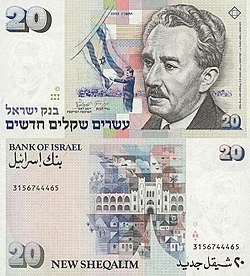 |
₪20 | dark gray | Moshe Sharett | The original building of Herzliya Gymnasium, Little Tel Aviv in background | 2 April 1988 | 1 July 2000 | |
 |
₪50 | purple | Shmuel Yosef Agnon | Jerusalem skyline, Eastern European shtetl, the setting of many of Agnon's stories. | 4 September 1985 | 1 July 2000 | |
 |
₪100 | brown | Yitzhak Ben-Zvi | Peki'in Synagogue with carob tree and cave, Ancient stone lamp | 19 August 1986 | 1 July 2000 | |
 |
₪200 | red | Zalman Shazar | A girl writing at a desk as a symbol of the Compulsory Education Law which was initiated by Shazar, and Hebrew block letters in background | 16 February 1992 | 1 July 2000 |
Series B (1999–2017)
The Second series of bank notes were released in 1999, replacing the first series by 2005. A plan to issue an ₪500 banknote, carrying the portrait of Yitzhak Rabin, was announced shortly after Rabin's assassination in 1995. However, due to low inflation rates, there was no need for such a banknote and it was never issued.[22]
| Image | Value | Dimensions | Colour | Obverse | Reverse | Date of issue |
|---|---|---|---|---|---|---|
  |
₪20 | 71x 138 mm | Green | Moshe Sharett | Jewish volunteers in World War II; a watchtower, commemorating tower and stockade settlements | 3 January 1999 |
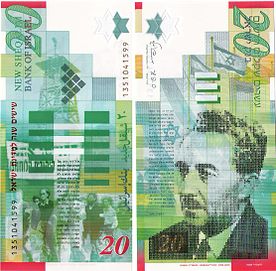 |
₪20 | Green | Moshe Sharett | Jewish volunteers in World War II; a watchtower, commemorating tower and stockade settlements. The additional red text on the polypropylene note reads "60 Years of the State of Israel" in Hebrew in red ink. It was only featured in a 1.8 million limited run close to the noted anniversary and is not present on a majority of notes. (Made of polypropylene, a polymer substrate, which is superior to the regular Series B paper note with a circulation life of a few months only. The polymer note is printed by Orell Füssli Security Printing of Zürich, Switzerland.) |
13 April 2008 | |
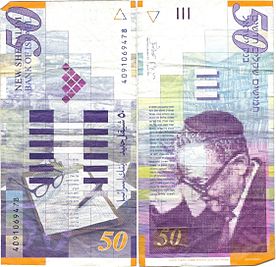 |
₪50 | Purple | Shmuel Yosef Agnon | Agnon's notebook, pen and glasses, Jerusalem and the Temple Mount | 31 October 1999 | |
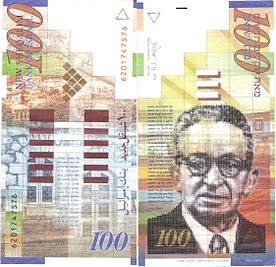 |
₪100 | Brown | Yitzhak Ben-Zvi | Peki'in Synagogue | 3 January 1999 | |
 |
₪200 | Red | Zalman Shazar | a street in Safed and text from Shazar's essay about Safed | 31 October 1999 | |
| ₪500 | Blue | Yitzhak Rabin | Part of a speech given by the late Prime Minister shortly before his assassination[23] | Never printed |
Series C (2014–present)
The committee proposed that the new series would bear the portraits of prominent Hebrew poets, among them Rachel, Shaul Tchernichovsky, Leah Goldberg and Nathan Alterman. In December 2010, it was announced that the series would feature portraits of Menachem Begin, Yitzhak Rabin, and Rachel and Shmuel Yosef Agnon.[24] When Begin's family opposed the decision, the committee's original proposal was readopted.[25]
On 14 November 2012, the Bank of Israel announced that the new series of banknotes is in the final stages of design. The first of the new banknotes to begin circulation was in the ₪50 denomination on 16 September 2014,[26] followed by the ₪200 note on 23 December 2015.[27] The final two denominations, ₪20 and ₪100, were issued on 23 November 2017, completing the "Series C" banknote series.[28][29][30]
With the issuing of the third series, the Bank of Israel has adopted the standard English spelling of shekel and plural shekels for its currency.[31] Previously, the Bank had formally used the Hebrew transcriptions of sheqel and sheqalim (from שְׁקָלִים).[32]
The banknotes are printed by Orell Füssli Security Printing of Switzerland.[2]
| Third Series of the New Shekel | ||||||
|---|---|---|---|---|---|---|
| Image | Value | Dimensions | Colour | Obverse | Reverse | Date of issue |
 |
₪20 | 129 x 71 mm | Red | Rachel Bluwstein; the poem Kinneret in microprinting; Palm tree branches in the background | Vista of the Sea of Galilee shoreline; Segment from the poem Perhaps it was nothing… | 23 November 2017 |
 |
₪50 | 136 x 71 mm | Green | Shaul Tchernichovsky; the poem Oh, My Land, My Homeland in microprinting; Citrus tree and its fruits in the background | Capital of a Corinthian column; Segment from the poem I Believe | 16 September 2014 |
 |
₪100 | 143 x 71 mm | Orange | Leah Goldberg; the poem In the land of my love the almond tree blossoms in microprinting; Almond tree blossoms in the background | A group of gazelles; Segment from the poem: White days | 23 November 2017 |
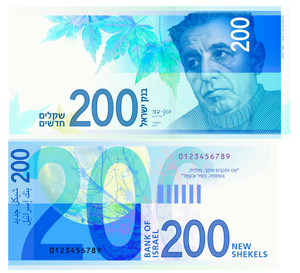 |
₪200 | 150 x 71 mm | Blue | Nathan Alterman; the poem Eternal Meeting in microprinting; Fall leaves in the background | Moonlit flora; Segment from the poem Morning Song | 23 December 2015 |
Exchange rates

| Currency | ISO 4217 | Unit | 1986 | 1991 | 1996 | 2001 | 2006 | 2011 | 2016 |
|---|---|---|---|---|---|---|---|---|---|
| United States dollar | USD | 1 | 1.36 | 2.59 | 3.36 | 4.22 | 4.47 | 3.46 | 3.77 |
| Soviet ruble | SUR1 | 1 | 1.80 | 4.61 | |||||
| Russian ruble | RUB | 1 | 0.62 | 0.14 | 0.16 | 0.12 | 0.05 | ||
| Japanese yen | JPY | 100 | 0.81 | 1.87 | 3.16 | 3.42 | 4.00 | 4.27 | 3.44 |
| Pound sterling | GBP | 1 | 2.07 | 4.47 | 5.16 | 6.10 | 8.36 | 5.53 | 5.15 |
| Deutsche Mark | DEM2 | 1 | 0.61 | 1.50 | 2.22 | ||||
| Euro | EUR | 1 | 3.63 | 5.65 | 4.91 | 4.25 | |||
| Swiss franc | CHF | 1 | 0.73 | 1.78 | 2.68 | 2.37 | 3.67 | 4.14 | 3.89 |
| Jordanian dinar | JOD | 1 | 4.25 | 3.34 | 4.50 | 5.89 | 6.44 | 4.81 | 5.32 |
| Egyptian pound | EGP | 1 | 2.12 | 0.72 | 0.94 | 1.07 | 0.77 | 0.57 | 0.42 |
| Renminbi | CNY | 1 | 0.39 | 0.47 | 0.39 | 0.50 | 0.55 | 0.55 | 0.58 |
| *1 SUR ceased to exist after 1993, and was replaced by RUB. *2 DEM ceased to exist after 1999, and was replaced by EUR. | |||||||||
| Current ILS exchange rates | |
|---|---|
| From Google Finance: | AUD CAD CHF CNY EUR GBP HKD JPY USD RUB CNY |
| From Yahoo! Finance: | AUD CAD CHF CNY EUR GBP HKD JPY USD RUB CNY |
| From XE.com: | AUD CAD CHF CNY EUR GBP HKD JPY USD RUB CNY |
| From OANDA: | AUD CAD CHF CNY EUR GBP HKD JPY USD RUB CNY |
See also
References
- ^ According to Article 4 of the 1994 Paris Protocol The Protocol allows the Palestinian Authority to adopt additional currencies. In the West Bank the Jordanian dinar is widely accepted and in the Gaza Strip the Egyptian pound is often used.
- ^ a b https://www.20min.ch/finance/news/story/Israel-laesst-in-Zuerich-Geld-drucken-25053913
- ^ a b "Israeli new shekel conversion". Metric Conversion charts and calculators. Retrieved 15 March 2018.
- ^ "אינפלציה ומדיניות מוניטרית > האינפלציה בפועל > המחירים לצרכן" (in Hebrew). Bank of Israel.
- ^ a b One Palestine Pound, IL: Bank of Israel, archived from the original on 27 April 2006
{{citation}}: Unknown parameter|deadurl=ignored (|url-status=suggested) (help) - ^ One Israeli Pound, IL: Bank of Israel, archived from the original on 27 September 2007
{{citation}}: Unknown parameter|dead-url=ignored (|url-status=suggested) (help) - ^ First Series of the Pound, IL: Bank Le-Israel, archived from the original on 27 September 2007
{{citation}}: Unknown parameter|dead-url=ignored (|url-status=suggested) (help) - ^ "CME to Launch Foreign Exchange Contract on Israeli Shekel" (Press release). Chicago Mercantile Exchange. 6 April 2006.
- ^ "Israelis can soon travel the world with shekels in their pockets". haaretz.com. Haaretz. Retrieved 15 March 2018.
- ^ "shekel begins trading on global markets". jpost.com. Jerusalem Post. Archived from the original on 13 August 2011. Retrieved 15 March 2018.
- ^ CLS Press Release (26 May 2008). "CLS Bank live with Israeli shekel and Mexican Peso". Archived from the original on 30 May 2008.
{{cite web}}: Unknown parameter|deadurl=ignored (|url-status=suggested) (help) - ^ http://fxtop.com/en/historical-exchange-rates-graph-zoom.php?C1=ILS&C2=USD&A=1&DD1=01&MM1=01&YYYY1=1997&DD2=12&MM2=10&YYYY2=2016&LARGE=1&LANG=en&VAR=0&MM1M=0&MM3M=0&MM1Y=0, Retrieved, 13 October 2016
- ^ "About the Agora and New Shekel Series". Banknotes and Coins Catalog. Bank of Israel. Retrieved 26 December 2007.
- ^ "5 NEW SHEQALIM". Banknotes and Coins Catalog. The Bank of Israel. Retrieved 26 December 2007.
- ^ "10 NEW SHEQALIM". Banknotes and Coins Catalog. The Bank of Israel. Retrieved 26 December 2007.
- ^ "The new NIS 2 coin" (Press release). The Bank of Israel. 8 July 2007. Retrieved 26 December 2007.
- ^ "Cancellation of the 5 agora coin" (in Hebrew). The Bank of Israel. 1 January 2008. Retrieved 4 September 2016.
- ^ Tomer Avital's report in Calcalist, 21 April 2011 (Hebrew)
- ^ Gad Lior's report in Ynet, 21 April 2011
- ^ Note that nickel-clad steel 1 new sheqalim coins were issued in 1994 and 1995
- ^ Linzmayer, Owen (2012). "Israel". The Banknote Book. San Francisco, CA: www.BanknoteNews.com.
- ^ "The 500 NIS banknote that was never released (Obverse)".
- ^ שטר בסימן שאלה, Bulletin of the Numismatics Association in Israel, October 2005
- ^ Press release, Bank of Israel, 19 December 2009
- ^ Press release, Bank of Israel, 10 March 2011
- ^ השטר החדש הושק: "יהי קשה לזייף שטרות" [The new banknote was launched: "It will be difficult to counterfeit banknotes"] (in Hebrew). ynet. 10 September 2014. Retrieved 10 September 2014.
- ^ "Israel's new NIS 200 note enters circulation today". Globes. 23 December 2015. Retrieved 23 December 2015.
- ^ Press release, Bank of Israel: The next banknotes in the new series – the NIS 20 and NIS 100 banknotes – will be distributed to the public on from Thursday, November 23, 2017 – 5 Kislev 5778 Bank of Israel (www.bankisrael.gov.il). 16 November 2017
- ^ Press release, Bank of Israel: Information on the new series of banknotes 14 November 2012
- ^ Press release by the Bank of Israel: Images and descriptions on the new series of Israeli new shekel banknotes Bank of Israel (www.bankisrael.gov.il). 28 April 2013. Retrieved on 1 May 2013.
- ^ "Third Series of the New Shekel", Currency, Bank of Israel
- ^ "Second Series of the New Shekel", Currency, Bank of Israel.
